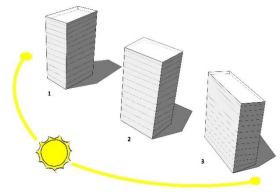Optimizing Residential Building Orientation for Sustainable Daylighting in the Tropics: A Case Study in Lagos, Nigeria

Submission to VIJ 2024-03-02
Keywords
- Building orientation,
- Daylighting,
- Energy efficiency,
- Sustainable design,
- Tropics
Abstract
Daylighting is an essential aspect of sustainable building design as it reduces reliance on artificial lighting, improves energy efficiency, and promotes a healthier indoor environment. However, in the tropics, where excessive solar heat gain and intense sunlight prevail, designing residential buildings that maximise daylight while minimising heat gain relies heavily on correctly obtaining the building orientation. This study explores the challenges faced in achieving optimal residential building orientation in the tropics and proposes guidelines and tools for operationalising residential building orientation in Lagos State. A mixed-method approach was employed by combining field observations, subjective surveys, and physical measurements. The orientations of the sampled residential buildings were identified using field observation procedures. A total of 1,168 residential buildings were sampled across 20 Local Government Areas of Lagos State. The findings reveal variations in residential building orientations across the North and South zones of Lagos State, with the majority having a northwest/southeast orientation. The implications of these orientations on energy efficiency, thermal comfort, and daylighting are discussed. Recommendations were provided for each orientation, suggesting strategies to address potential issues and optimise daylighting. This study underscores the importance of considering building orientation for sustainable design practices in Lagos, Nigeria. By implementing the suggested building orientation guidelines, architects can achieve and enhance the visual comfort and energy efficiency of residential building occupants in Lagos State.
References
- P. Lotfabadi and P. Hançer, ‘Optimization of visual comfort: Building openings’, Journal of Building Engineering, vol. 72, p. 106598, Aug. 2023, doi: 10.1016/j.jobe.2023.106598.
- C. M. Muñoz, P. M. Esquivias, D. Moreno, I. Acosta, and J. Navarro, ‘Climate-based daylighting analysis for the effects of location, orientation and obstruction’, Lighting Research & Technology, vol. 46, no. 3, pp. 268–280, 2014, doi: 10.1177/1477153513487005.
- J. J. Anumah and L. Anumah, ‘Building orientation; enhancing nature with nature’, 2017.
- A. Tabadkani, S. Banihashemi, and M. R. Hosseini, ‘Daylighting and visual comfort of oriental sun responsive skins: A parametric analysis’, in Building simulation, Springer, 2018, pp. 663–676. doi: https://doi.org/10.1007/s12273-018-0433-0.
- S. Yarramsetty, M. S. Rohullah, M. V. N. Sivakumar, and A. R. P, ‘An investigation on energy consumption in residential building with different orientation: a BIM approach’, Asian J Civ Eng, vol. 21, no. 2, pp. 253–266, Mar. 2020, doi: 10.1007/s42107-019-00189-z.
- M. Dutta, ‘Maximizing the Benefits of Daylight in Residential Design and Construction: A Review of Modern Homes and Villas’, Studies in Art and Architecture, vol. 2, no. 1, pp. 16–20, 2023, doi: 10.56397/SAA.2023.03.03.
- L. H. Sari and E. N. Rauzi, ‘An evaluation of shading device in tropics utilising the sun-path diagram’, ARTEKS J. Tek. Arsit., vol. 6, no. 3, pp. 373–382, Dec. 2021, doi: 10.30822/arteks.v6i3.877.
- A. Kaminska, ‘Impact of Building Orientation on Daylight Availability and Energy Savings Potential in an Academic Classroom’, Energies, vol. 13, no. 18, p. 4916, 2020, doi: 10.3390/en13184916.
- Mohammad, Hakimazari, Seyedehmamak, and Salavatian, ‘Manuscript Title Impact of Window Factors and Building Orientation on Energy-consumption in Residential Buildings of Humid Temperate Climatic Zone in Iran Authors’, 2021. Accessed: May 12, 2023. [Online]. Available: https://www.semanticscholar.org/paper/Manuscript-Title-Impact-of-Window-Factors-and-on-in-Mohammad-Hakimazari/25320c224d897dad61687fc1f075516bc998debd
- M. A. Alkali et al., ‘Optimizing Building Orientation for Reduced Cooling Load in Northeast Nigeria’s Residential Architecture’, IOP Conf. Ser.: Earth Environ. Sci., vol. 793, no. 1, p. 012028, Jun. 2021, doi: 10.1088/1755-1315/793/1/012028.
- B. Basnet and S. Uprety, ‘A Pilot Study on the Effect of Daylighting and Orientation in the Office Building: A Case of Kathmandu’, Adv. Engin. & Technol., vol. 2, no. 01, pp. 33–45, Dec. 2022, doi: 10.3126/aet.v2i01.50435.
- R. Elghamry and N. Azmy, ‘Buildings orientation and it’s impact on the energy consumption’, Dec. 2017.
- P. G. A. S. K. W. Notodipuro and A. Mandala, ‘The effect of building shape and orientation on energy use at sloped sites in tropical climates using sefaira’, ARTEKS J. Tek. Arsit., vol. 7, no. 1, pp. 131–142, Apr. 2022, doi: 10.30822/arteks.v7i1.1397.
- I. R. Edmonds and P. J. Greenup, ‘Daylighting in the tropics’, Solar energy, vol. 73, no. 2, pp. 111–121, 2002, doi: 10.1016/S0038-092X(02)00039-7.
- T. Dabe, ‘Assessment of Daylight into the Residential Building According to the Floor Levels for Hot and Dry Climatic Zone’, Journal of Architectural Environment & Structural Engineering Research, vol. 2, Aug. 2019, doi: 10.30564/jaeser.v2i2.376.
- Z. A. Kiliç and A. Köknel Yener, ‘Determining Proper Daylighting Design Solution for Visual Comfort and Lighting Energy Efficiency: A Case Study for High-Rise Residential Building’, J. Phys.: Conf. Ser., vol. 2069, no. 1, p. 012156, Nov. 2021, doi: 10.1088/1742-6596/2069/1/012156.
- S. V. Szokolay, ‘Environmental Science Handbook for Architects and Builders: S.V. Szokolay The Construction Press, 532 pp., ISBN 0 86095 813 2 £25.00 (1980)’, Building and Environment, vol. 15, no. 3, p. 199, Jan. 1980, doi: 10.1016/0360-1323(80)90040-2.
- Census, ‘Nigeria - Population and Housing Census 2006’. Accessed: May 12, 2023. [Online]. Available: https://catalog.ihsn.org/index.php/catalog/3340
- E. Ochedi and A. H. Taki, ‘Energy Efficient Building Design in Nigeria: An Assessment of the Effect of the Sun on Energy Consumption in Residential Buildings’, 2019, doi: 10.15640/jea.v7n1a6.
- J. A. Jakubiec, T. Srisamranrungruang, Z. Kong, G. Quek, and R. Talami, ‘Subjective and measured evidence for residential lighting metrics in the tropics’, Building Simulation, Rome, Italy, 2019, doi: https://doi.org/10.26868/25222708.2019.210898.